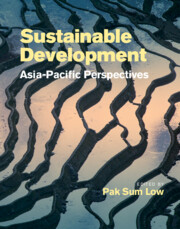Book contents
- Sustainable Development: Asia-Pacific Perspectives
- Sustainable Development: Asia-Pacific Perspectives
- Copyright page
- Dedication
- Contents
- Notes on contributors
- Peer reviewers
- Editor’s note
- Foreword
- Foreword
- Foreword
- Foreword
- Foreword
- Environmental keystones: Remembering Dr Mostafa Kamal Tolba
- Remembering Dr Mostafa Kamal Tolba
- Remembering Dr Mostafa Kamal Tolba
- Acronyms and abbreviations
- SI prefixes
- Unit abbreviations
- Chemical formulae
- Part I Sustainable Development: Theories and Practices
- Part II Sustainable Development: Challenges and Opportunities
- 17 Scientific responses in an era of global change
- 18 Government communication on transboundary haze: The nexus between public health and tourism
- 19 Biomass energy prospects: A promising fuel for sustainable development in Asia and the Pacific
- 20 Pathways to a more sustainable electricity sector in India
- 21 Gender equality and energy access: Barriers to maximizing development effectiveness in the SAARC region
- 22 The biosphere and the interactions between stratospheric ozone depletion and climate change
- 23 The political challenge of linking climate change and sustainable development policies: Risks and prospects
- 24 Social vulnerability to climate change in Cambodia, Lao PDR, and Vietnam
- 25 Sustainable development in Bangladesh: Bridging the SDGs and climate action
- 26 Sustainable development in Pakistan: Vulnerabilities and opportunities
- 27 Beyond protected areas: Biodiversity conservation and global change in Asia and the Pacific
- 28 Causes of land-use change and biodiversity loss in Monsoon Asia
- 29 Assessing linkages between land use and biodiversity: A case study from the Eastern Himalayas using low-cost, high-return survey technology
- 30 Where to invade next: Inaction on biological invasions threatens sustainability in a small island developing state of the tropical South Pacific
- 31 Did the Indian Ocean tsunami trigger a shift towards disaster risk reduction?
- 32 Cyclone Nargis and disaster risk management in Myanmar
- Index
- Endmatter
- References
32 - Cyclone Nargis and disaster risk management in Myanmar
from Part II - Sustainable Development: Challenges and Opportunities
Published online by Cambridge University Press: 23 December 2021
- Sustainable Development: Asia-Pacific Perspectives
- Sustainable Development: Asia-Pacific Perspectives
- Copyright page
- Dedication
- Contents
- Notes on contributors
- Peer reviewers
- Editor’s note
- Foreword
- Foreword
- Foreword
- Foreword
- Foreword
- Environmental keystones: Remembering Dr Mostafa Kamal Tolba
- Remembering Dr Mostafa Kamal Tolba
- Remembering Dr Mostafa Kamal Tolba
- Acronyms and abbreviations
- SI prefixes
- Unit abbreviations
- Chemical formulae
- Part I Sustainable Development: Theories and Practices
- Part II Sustainable Development: Challenges and Opportunities
- 17 Scientific responses in an era of global change
- 18 Government communication on transboundary haze: The nexus between public health and tourism
- 19 Biomass energy prospects: A promising fuel for sustainable development in Asia and the Pacific
- 20 Pathways to a more sustainable electricity sector in India
- 21 Gender equality and energy access: Barriers to maximizing development effectiveness in the SAARC region
- 22 The biosphere and the interactions between stratospheric ozone depletion and climate change
- 23 The political challenge of linking climate change and sustainable development policies: Risks and prospects
- 24 Social vulnerability to climate change in Cambodia, Lao PDR, and Vietnam
- 25 Sustainable development in Bangladesh: Bridging the SDGs and climate action
- 26 Sustainable development in Pakistan: Vulnerabilities and opportunities
- 27 Beyond protected areas: Biodiversity conservation and global change in Asia and the Pacific
- 28 Causes of land-use change and biodiversity loss in Monsoon Asia
- 29 Assessing linkages between land use and biodiversity: A case study from the Eastern Himalayas using low-cost, high-return survey technology
- 30 Where to invade next: Inaction on biological invasions threatens sustainability in a small island developing state of the tropical South Pacific
- 31 Did the Indian Ocean tsunami trigger a shift towards disaster risk reduction?
- 32 Cyclone Nargis and disaster risk management in Myanmar
- Index
- Endmatter
- References
Summary
The devastating cyclone ‘Nargis’ struck the Myanmar coast on the evening of 2 May 2008. Prior to Nargis, no cyclone making landfall in Myanmar had ever been on the list of ‘deadliest tropical cyclones’ in the whole tropical region. Official figures reported that 84,500 people were killed and 53,800 went missing (). Nargis became the eighth-deadliest tropical cyclone in the world, in addition to leaving a huge impact on the social and economic sectors of the country, with an estimated cost of more than 11 trillion kyat (US$8,317,580) in damages.
The effect of climate change is evident when one looks at the case of Nargis, especially upon studying its track.found that the latitude of recurvature of Bay of Bengal storms in the pre-monsoon season had shifted southwards from the latitude of Bangladesh (>20° North) to the latitude of the Myanmar delta area (around 16° North). This latitudinal shift is clearly seen after the 1980s in the decadal average of 850 hPa winds. In addition, the decadal mean sea surface temperature anomalies (SSTA) in the Bay of Bengal for the pre-monsoonal periods clearly show that they have changed from negative to positive, starting from 1980. Furthermore, a maximum positive SSTA centre is observed in the vicinity of Preparis Island, one of the Andaman Islands, from which most storms with a landfall on the Myanmar coast originate. These changes have had a significant impact on the region, as a result.
The high loss of human lives and property during Nargis was due to the high vulnerability of the delta areas associated with both climatic and non-climatic factors. This chapter discusses those factors so as to learn lessons, with a view to reducing the risks in similar disasters in the future. Disaster risk reduction and management will have significant implications for sustainable development in Myanmar.
- Type
- Chapter
- Information
- Sustainable Development: Asia-Pacific Perspectives , pp. 414 - 430Publisher: Cambridge University PressPrint publication year: 2022

